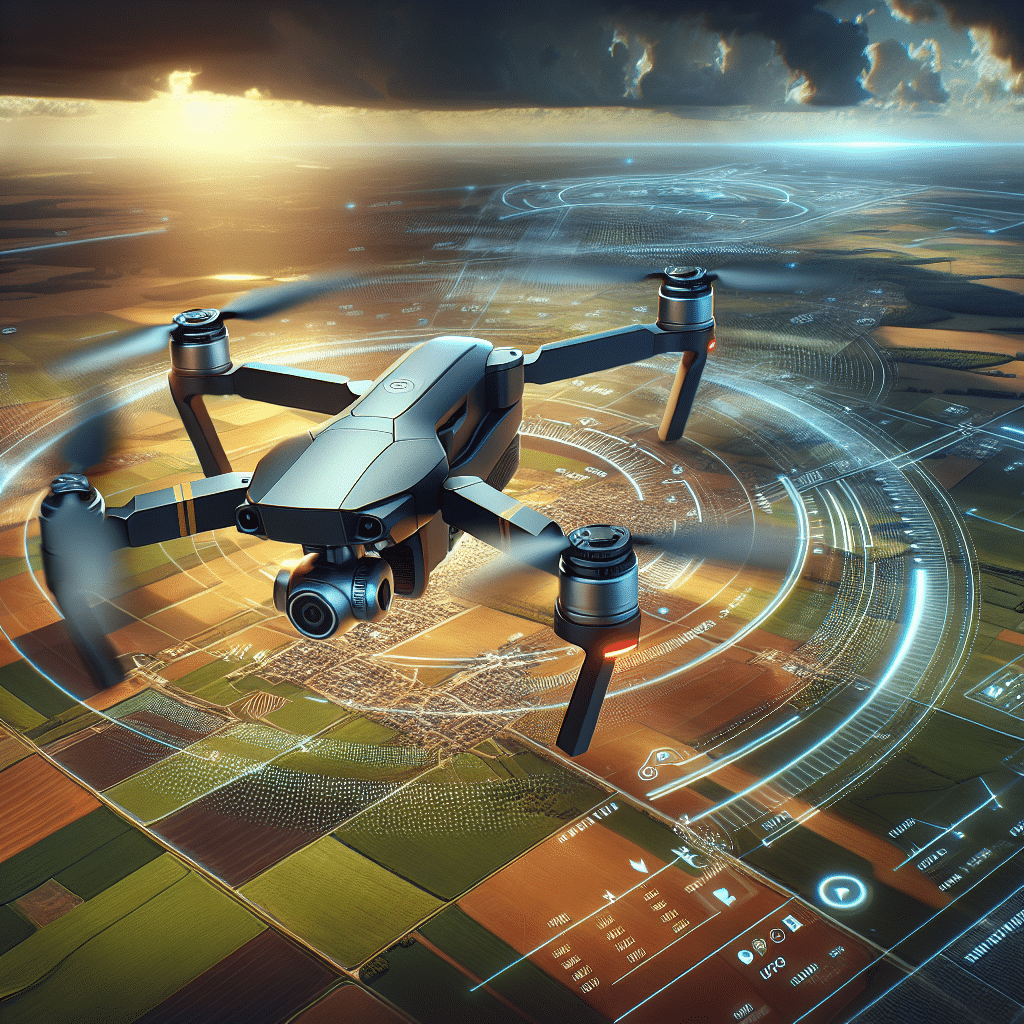GPS Waypoint Navigation Enhances Drone Mapping Accuracy
In This Article
- GPS Waypoint Navigation enables drones to autonomously follow precise, repeatable flight paths.
- It improves data quality, workflow efficiency, and safety across mapping and surveying operations.
- Industries such as agriculture, construction, and insurance rely heavily on this technology.
- Despite challenges related to signal reliability and drone range, careful planning mitigates most issues.
- Utilising the right software tools is critical to successful waypoint mission execution.
- Beginners should start small, study regulations, and take advantage of knowledge platforms like Read a related article.
Understanding GPS Waypoint Navigation
What is GPS Waypoint Navigation?
GPS Waypoint Navigation refers to the use of Global Positioning System (GPS) coordinates to create predefined routes or “waypoints” that guide a drone through specific locations. This navigation technique enables drones to follow a planned path autonomously, ensuring accuracy and repeatability in aerial missions. Initially developed for military applications, this technology has become indispensable in commercial and industrial contexts. By relying on satellite-linked positional data, drones can fly autonomously, collecting geospatial data along precise grid paths. This eliminates the margin of human error found in manual piloting and significantly enhances mission reliability.

How Drones Use GPS for Mapping
Smart Route Automation Through Waypoints
Drones harness GPS Waypoint Navigation to automate flight paths with pinpoint accuracy. Operators input a series of GPS coordinates into flight planning software to construct a pattern of waypoints. The software then calculates altitude, camera angle, speed, and overlap rates between images. This pre-flight planning ensures that the drone captures uniform, high-quality data, optimised for geospatial analysis. The consistency across mapping missions greatly reduces post-processing inefficiencies. More importantly, executing precise, repetitive flights is impossible through manual piloting. Drones using this system fly autonomously, maintaining stable altitudes even in diverse terrain.
“Automating drone navigation via GPS waypoints eliminates human error, enhances efficiency, and standardises aerial image quality.”
Benefits of Automated Aerial Mapping
Employing GPS Waypoint Navigation in aerial mapping introduces numerous operational and strategic benefits. Firstly, automation notably reduces personnel requirements; tasks that would demand multiple operators can now be handled by a single technician. This translates to reduced operational costs and fewer logistical complications. Secondly, the pre-programmed nature of waypoint navigation ensures data consistency. Each mission can replicate previous flights with exactitude, which is vital when conducting longitudinal studies or monitoring change over time, such as erosion rates or crop health. In commercial surveying, data integrity is paramount, and GPS-powered mapping safeguards it at every turn. Additionally, automatically captured data integrates smoothly with GIS (Geographic Information Systems), creating seamless workflows for urban planners, environmental scientists, and engineers. These benefits culminate in faster project deliveries, cost-effective operations, and more robust insights drawn from aerial data.
Precision Gains in Surveying & Agriculture
GPS Waypoint Navigation has carved a niche in both land surveying and agricultural applications thanks to its ability to deliver highly detailed data. In surveying, drones can follow exact routes over a construction site, canyon, or coastline, capturing centimetre-grade data for 3D modelling and topographic maps. The advantage lies in the repeatability of these routes, allowing engineers to regularly assess developmental changes. This is especially valuable in large-scale infrastructure projects, where progress must be documented layer by layer. In agriculture, precision matters at a microscopic level. Farmers use waypoint-enabled drones to evaluate crop health, manage irrigation, and identify pest infestations. These drones fly over orchards and plantations, capturing multispectral images that reveal plant stress markers invisible to the naked eye. Consequently, agricultural interventions become highly targeted, reducing reliance on water, fertilisers, and pesticides. This precision translates into improved yields and enhanced sustainability — two crucial requirements for feeding a growing global population.
Drone Models Supporting Waypoint Modes
Several commercial drone platforms natively support GPS Waypoint Navigation. Leading the industry is DJI, whose drones such as the Phantom 4 RTK, Mavic 3 Enterprise, and Matrice 300 are engineered for waypoint missions. These models integrate advanced flight control systems with high-precision RTK GNSS modules, delivering centimetre-level positioning accuracy. Other manufacturers like Parrot and Yuneec also offer mapping-capable drones that use waypoint functionality, popular in fields like environmental science and infrastructure inspection. An increasingly popular trend is the custom integration of autopilot systems such as Pixhawk, Cubepilot, or Ardupilot into bespoke drone airframes. These open-source platforms support configurable waypoint routines via ground control software like QGroundControl or Mission Planner. As drone hardware becomes more modular, flexibility in supporting various waypoint modes continues to expand. Additionally, many of these systems include obstacle avoidance and live telemetry features, further enhancing safety and reliability during autonomous missions.
Waypoint Mapping vs Manual Flight
When comparing GPS Waypoint Navigation against manual drone flight, the advantages of autonomy become immediately apparent. Manual flights require top-tier piloting skills, and even experienced operators can introduce inconsistencies in altitude, overlap, and image spacing. Variations like these compromise data quality, requiring extensive corrections during post-processing. In contrast, waypoint flights eliminate these inconsistencies entirely. Waypoints ensure a uniform flight path, capturing data in standardised formats. Moreover, mapping large areas manually is highly time-consuming and mentally taxing. Automated flights can be pre-programmed and repeated with minimal human oversight, making them ideal for large land parcels, long-term monitoring, and high-stakes infrastructure surveillance. While manual flights might still serve utility purposes—such as real-time inspection or reactive surveying—GPS Waypoint Navigation offers superior performance when accuracy, scalability or mapping fidelity is the mission’s priority.
Industry Use Cases of GPS Mapping
Use cases for GPS Waypoint Navigation span diverse industries, each benefiting from its reliability and efficiency. In civil engineering, drone mapping supports road development, bridge inspections, and earthworks monitoring. Government agencies use waypoint-aided drones for environmental mapping, including flood risk analysis and land use planning. In renewable energy sectors, such as solar and wind, drones chart terrain suitability and inspect installations. The insurance industry uses aerial maps for risk assessment and claims verification, particularly following natural disasters. Precision agriculture, perhaps one of the most rapidly expanding sectors, relies heavily on regular, repeated aerial mapping to manage vast farmland optimally. Archaeologists leverage GPS waypoints to document excavation sites without damaging fragile locations. Even humanitarian efforts employ mapping drones to assess disaster zones and dispatch timely relief. These versatile applications underline how GPS-powered aerial mapping bolsters operational readiness and strategic decision-making across disciplines.
Challenges in Waypoint Implementation
Despite clear advantages, implementing GPS Waypoint Navigation is not without hurdles. One major challenge involves satellite reliability; dense canopies, urban buildings, or steep terrain can degrade GPS signal quality, leading to navigation errors. Weather conditions, especially high winds or rain, also affect drone stability, which can impact data accuracy. These risks are manageable but require contingency planning. Software integration presents another difficulty. Mission planning applications must be compatible with drone hardware, sensors, and processing workflows. Compatibility issues can delay operations or require costly software licensing and training. Moreover, legal restrictions surrounding autonomous drone flights vary by country and region. Operators must be thoroughly familiar with local aviation regulations and secure appropriate permissions if required. Finally, battery life imposes limits on waypoint mission duration. While high-end drones offer extended flight times, mapping expansive areas may still require multiple sorties and battery swaps. Understanding and mitigating these limitations ensures successful deployment.
Tools & Software for Waypoint Planning
Successful waypoint missions hinge on the right combination of tools and software. Popular flight planning software includes DJI GS Pro, Litchi, DroneDeploy, and Pix4Dcapture. These applications allow users to set waypoints visually using satellite imagery, parameterise flight details such as overlap, gimbal angle, and return-to-home criteria. Many platforms also provide real-time telemetry and mission updates. For open-source drone systems like Ardupilot or PX4, software such as Mission Planner or QGroundControl enables highly customisable missions, including 3D flight path editing. Image processing software like Pix4Dmapper, DroneDeploy, or Agisoft generates orthomosaics, 3D models, and digital elevation models from captured imagery. Integration with cloud-based GIS systems then allows for collaborative analysis and storage. To maximise efficiency, professionals typically combine multiple tools, ensuring processes from planning to post-processing are seamless. Proper calibration and testing ensure mission success, so regular software updates and equipment maintenance are also essential.
Tips for Beginners in GPS Drone Mapping
For newcomers to GPS Waypoint Navigation, the learning curve can seem steep, but practical planning eases the transition. First, begin with smaller test areas to familiarise yourself with your chosen drone and software. Review every mission plan before launch, paying special attention to altitude, battery estimates, and return-to-home parameters. Always conduct a pre-flight checklist to ensure firmware is updated, batteries are charged, and GPS locks are stable. Backup your mission plan and bring extra batteries if covering larger zones. When selecting sensors, consider your end-goals, whether they be RGB for visual inspections or multispectral imaging for agriculture. Understanding post-processing needs in advance can also influence flight parameters. Lastly, educate yourself on regional UAV regulations to ensure compliance. Valuable knowledge from communities like Learn more about Drone Navigation & Mapping Technology and resources such as How drones utilise GPS for flight precision can accelerate your proficiency and mission success.
Conclusion: Mapping the Future with Drones
[CONCLUSION_CONTENT]
Great guide on how-gps-waypoint-navigation-transforms-aerial-mapping – Community Feedback
What is GPS waypoint navigation?
GPS waypoint navigation is a system that enables drones or robots to autonomously travel between predefined GPS coordinates, allowing precise route planning and often including support for obstacle detection along the flight path.
What is the purpose of the term waypoint navigation in drone operation?
Waypoint navigation allows drone pilots to set predefined GPS points for the drone to follow autonomously, improving route consistency and enabling features like automatic Return-to-Home if the battery is low or if the connection is lost.
What is the purpose of drone mapping?
Drone mapping generates high-resolution, accurate aerial data, providing better detail and insights than traditional surveying, leading to more informed decision-making and efficient analysis in various industries.
Which DJI drones can use waypoints?
DJI drones such as Mavic 4 Pro, Air 3S, Mini 4 Pro, Air 3, Mavic 3 Pro, Mavic 3 Cine, and Mavic 3 Classic support waypoint flight modes, allowing users to predefine routes for automated missions.

